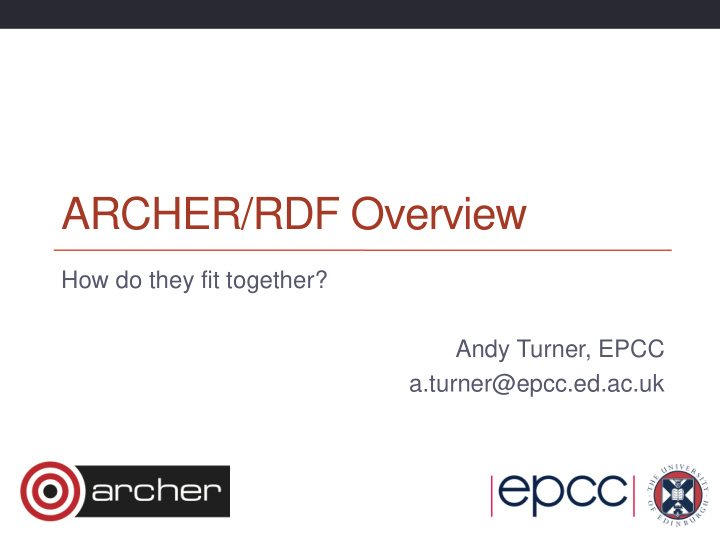



ARCHER/RDF Overview How do they fit together? Andy Turner, EPCC a.turner@epcc.ed.ac.uk
www.epcc.ed.ac.uk www.archer.ac.uk
Outline • ARCHER/RDF • Layout • Available file systems • Compute resources • ARCHER Compute Nodes • ARCHER Pre/Post-Processing (PP) Nodes • RDF Data Analytic Cluster (DAC) • Data transfer resources • ARCHER Login Nodes • ARCHER PP Nodes • RDF Data Transfer Nodes (DTNs)
ARCHER and RDF
ARCHER • UK National Supercomputer • Large parallel compute resource • Cray XC30 system • 118,080 Intel Xeon cores • High performance interconnect • Designed for large parallel calculations • Two file systems • /home – Store source code, key project data, etc. • /work – Input and output from calculations, not long-term storage
RDF • Large scale data storage (~20 PiB) • For data under active use, i.e. not an archive • Multiple file systems available depending on project • Modest data analysis compute resource • Standard Linux cluster • High-bandwidth connection to disks • Data transfer resources
Terminology • ARCHER • Login – Login nodes • PP – Serial Pre-/Post-processing nodes • MOM – PBS job launcher nodes • /home – Standard NFS file system • /work – Lustre parallel file system • ARCHER installation is a Sonexion Lustre file system • RDF • DAC – Data Analytic Cluster • DTN – Data Transfer Node • GPFS – General Parallel File System • RDF parallel file system technology from IBM • Multiple file systems available on RDF GPFs
Overview DTN Login PP MOM DAC Compute Nodes RDF File Systems /home /work GPFS Parallel NFS Lustre Parallel RDF ARCHER
Available File Systems
ARCHER • /home • Standard NFS file system • Backed up daily • Low-performance, limited space • Mounted on: Login, PP, MOM (not Compute Nodes) • /work • Parallel Lustre file system • No backup • High performance read/write (not open/stat), large space (>4 PiB) • Mounted on: Login, PP, MOM, Compute Nodes
RDF • /epsrc, /nerc, /general • Parallel GPFS file system • Backed up for disaster recovery • High performance (read/write/open/stat), v. large space (>20 PiB) • Mounted on: DTN, DAC, Login, PP
Compute Resources
ARCHER • Compute Nodes: • 4920 nodes with 24 cores each (118,080 cores total) • 64/128 GB memory per node • Designed for parallel jobs (serial not well supported) • /work file system only • Accessed by batch system only • PP Nodes • 2 nodes with 64 cores each (256 hyperthreads in total) • 1 TB memory per node • Designed for serial/shared-memory jobs • RDF file systems available • Access directly or via batch system
RDF • Data Analytic Cluster • 12 standard compute nodes: 40 HyperThreads, 128 GB Memory • 2 large compute nodes: 64 HyperThreads, 2 TB Memory • Direct Infiniband connections to RDF file systems • Access via batch system • Designed for data-intensive workloads in parallel or serial
Data Transfer Resources • ARCHER to/from RDF • Primary resource is PP nodes • Mounts ARCHER and RDF file systems • Interactive data transfer can use ARCHER Login nodes • Mounts ARCHER and RDF file systems • Small amounts of data only • To outside world • RDF Data Transfer Nodes (DTNs) for large files • ARCHER Login Nodes for small amounts of data only
Summary
ARCHER/RDF • ARCHER and the RDF are separate systems • Some RDF file systems are mounted on ARCHER login and PP nodes • To enable easy data transfer (e.g. for analysis or transfer off site) • A variety of file systems are available • Each has its own use case • Data management plan should consider which is best suited at each stage in data lifecycle • Variety of compute resources available
Recommend
More recommend